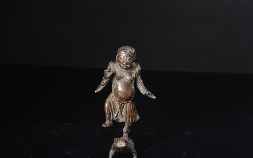青铜收藏古玩(古玩杂货青铜器)
青铜器(Bronze Ware)在古时被称为“金”或“吉金”,是红铜与其他化学元素锡、铅等的合金,其铜锈呈青绿色。
青铜器的使用开始于新石器时代晚期的土耳其和伊拉克地区,及叙利亚古代TellRamad遗址出土的铜珠等 。中国青铜器开始于马家窑至秦汉时期,以商周时期的器物最为精美。 在中国仰韶文化早期和马家窑文化时期就已经出现。
中国最初出现的是小型工具或饰物。夏代始有青铜容器和兵器。商中期,青铜器品种已很丰富,并出现了铭文和精细的花纹。商晚期至西周早期,是青铜器发展的鼎盛时期,器型多种多样,浑厚凝重,铭文逐渐加长,花纹繁缛富丽。随后,青铜器胎体开始变薄,纹饰逐渐简化。春秋晚期至战国,由于铁器的推广使用,铜制工具越来越少。秦汉时期,随着陶器和漆器进入日常生活,铜制容器品种减少,装饰简单,多为素面,胎体也更为轻薄。
中国青铜器制作精美,在世界青铜器中享有极高的声誉和艺术价值,代表着中国5000多年青铜发展的高超技术与文化。
青铜罐

西周地雷罐,造型如抗战地雷,回纹通身遍体,腹肚鼓圆,盘口不规,虽粗而朴,罕见高古。西周 地雷罐,现藏浙东越窑青瓷博物馆,根据以上考古记载,与西周时期的青铜器类似,此罐盖如方向盘,双环耳,形似地雷。

“干坑”是指地势较高干燥的黄土地带。如中原、华北、西安、四川等地,含酸、盐、铁多种元素,例如埋藏的青铜器经几千年的土壤中各种化合物的侵蚀和氧化,长出一层层红色的斑纹和绿锈,这是干坑出土青铜器的特色,称之为红斑绿锈的“干坑皮壳”。

表面氧化成青铜绿锈,可见年代之久远,青铜器跨越整个中华文明,具有极高的收藏价值,是我国的国粹,当为传世之宝。
方耳尊

西周早期(公元前11世纪) 尊也是一种盛酒器,一般为圆形。这对尊为圆口方体,双环耳。此器形体虽不大,而其气度则深厚雄健,仿佛大器。

中国最初出现的是小型工具或饰物。夏代始有青铜容器和兵器。商中期,青铜器品种已很丰富,并出现了铭文和精细的花纹。商晚期至西周早期,是青铜器发展的鼎盛时期,器型多种多样,浑厚凝重,铭文逐渐加长,花纹繁缛富丽。随后,青铜器胎体开始变薄,纹饰逐渐简化。春秋晚期至战国,由于铁器的推广使用,铜制工具越来越少。秦汉时期,随着陶器和漆器进入日常生活,铜制容器品种减少,装饰简单,多为素面,胎体也更为轻薄。

青铜礼器是奴隶主贵族用于祭祀、宴飨、朝聘、征伐及丧葬等礼仪活动的用器,用以代表使用者的身份等级和权力,是立国传家的宝器。青铜礼器种类繁多,数量巨大,工艺精美,其存在是中国古代青铜器的显着特点,这对青铜器并非使用器,故而磨损较少,保存完好,具有极高的收藏价值。
英文翻译:Bronze Ware, called "gold" or "gold" in ancient times, is an alloy of red copper with other chemical elements such as tin and lead. Its copper rust is bluish green.
The use of bronze ware began in the late Neolithic Age in Turkey and Iraq, and the ancient TellRamad site in Syria unearthed copper beads. Chinese bronzes began from Majiayao to the Qin and Han dynasties, with the most exquisite ones from the Shang and Zhou dynasties. It appeared in the early period of Yangshao culture and Majiayao culture.
China first appeared in small tools or accessories. The Xia dynasty began to have bronze vessels and weapons. In the middle period of shang Dynasty, bronze ware varieties were abundant, and inscriptions and fine patterns appeared. From the late Shang dynasty to the early Western Zhou Dynasty, bronze ware was in its heyday, with various types, thick and dignified, gradually lengthened inscriptions and elaborate patterns. Later, the bronze body began to thin, gradually simplified ornamentation. From the late Spring and Autumn period to the Warring States period, copper tools became less and less due to the popularization of iron ware. During the Qin and Han Dynasties, with the introduction of pottery and lacquer into daily life, the variety of copper vessels was reduced and the decoration was simple. Most of them were plain and the body was thinner.
Chinese bronzes are exquisitely made and enjoy a high reputation and artistic value among bronzes in the world, representing the superb technology and culture of Chinese bronze development over 5,000 years.
Bronze POTS
The mine pot in the Western Zhou Dynasty is shaped like an anti-war mine. It is covered all over with patterns, with round belly and irregular mouth. Although it is coarse and simple, it is rare in ancient Times. The mine jar of the Western Zhou Dynasty is now stored in the Yue Kiln Celadon Museum in eastern Zhejiang. According to the archaeological records above, it is similar to the bronze ware of the Western Zhou Dynasty. The jar's lid is like a steering wheel with double ears, and it looks like a mine.
"Dry pit" refers to the loess belt with higher and dry terrain. For example, in central China, North China, Xi 'an, Sichuan and other places, buried bronzes containing various elements such as acid, salt and iron have developed layers of red markings and green rust after thousands of years of erosion and oxidation of various compounds in the soil. This is the characteristic of bronze excavated from dry pits, which is called "dry pit skin shell" with red spots and green rust.
The surface is oxidized into bronze green rust, which can be seen from a long time ago. Bronzes span the entire Chinese civilization and have a high collection value. They are the quintessence of China and should be handed down as a treasure.
The ear honour
In the early Western Zhou Dynasty (11th century BC), Zun was also a wine vessel, generally round. This pair is round mouth square body, double ring ear. Although the shape of the vessel is not big, its bearing is deep and vigorous, as if it were a big vessel.
China first appeared in small tools or accessories. The Xia dynasty began to have bronze vessels and weapons. In the middle period of shang Dynasty, bronze ware varieties were abundant, and inscriptions and fine patterns appeared. From the late Shang dynasty to the early Western Zhou Dynasty, bronze ware was in its heyday, with various types, thick and dignified, gradually lengthened inscriptions and elaborate patterns. Later, the bronze body began to thin, gradually simplified ornamentation. From the late Spring and Autumn period to the Warring States period, copper tools became less and less due to the popularization of iron ware. During the Qin and Han Dynasties, with the introduction of pottery and lacquer into daily life, the variety of copper vessels was reduced and the decoration was simple. Most of them were plain and the body was thinner.
Bronze ritual vessels are used by slaveholders and nobles for ritual activities such as sacrifice, feast, imperial engagement, expedition and funeral. They are used to represent the status and power of the users, and are precious vessels for establishing the country and passing down the family. Bronze ritual vessels are diverse, large in number and exquisite in workmanship. Their existence is a remarkable feature of ancient Chinese bronzes. They are not used, so they are less worn and well preserved and have a high collection value.
古玩帮文章均系玩家上传分享,仅供网友学习交流。如作品内容涉及版权问题,请及时与古玩帮联系,我们将在第一时间删除。文章地址:https://www.guwanbang.com/shijie/4741.html




